|
84. Melanargia galathea (Linnaeus, 1758) / Marbled white / Nymphalidae – Satyrinae
NL: dambordje / D: Schachbrett, Schachbrettfalter / F: demi-deuil
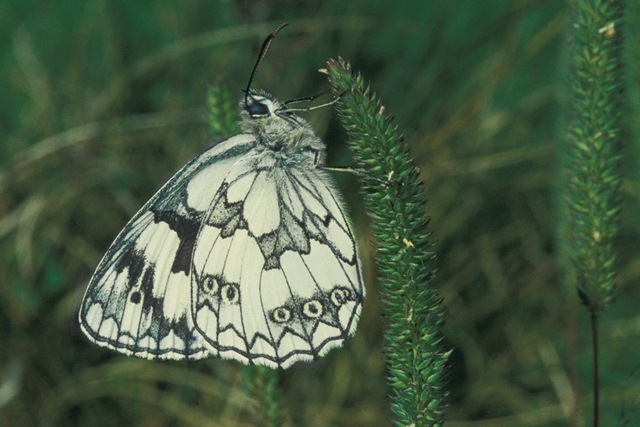 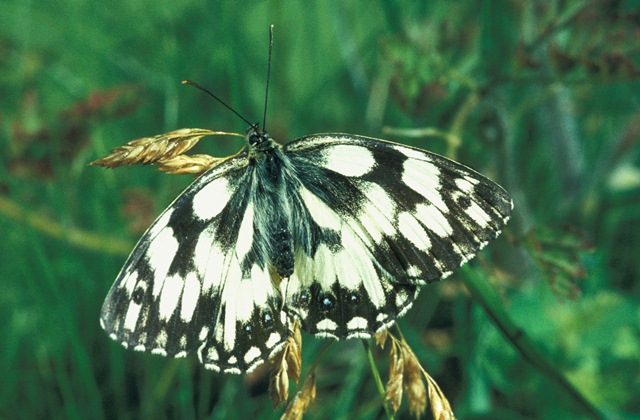 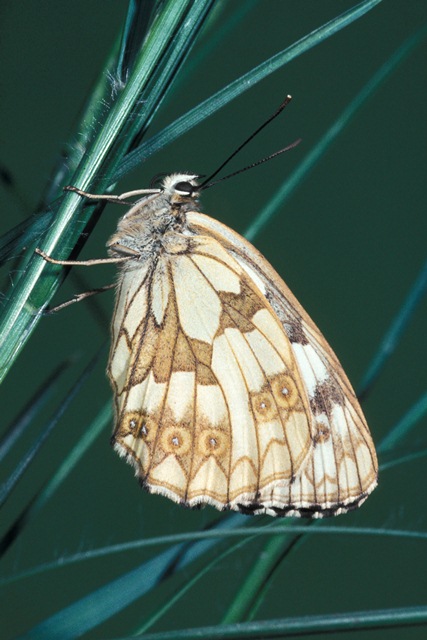
Photographs: Frits Bink ©.
Medium-sized or large, wing length 25 (23-26) mm. In the Benelux the species is a permanent inhabitant of tall grassland on slopes of warm chalk hills but occurs also on fertile and humid sites. In Flanders and the Netherlands it occurs irregularly. In England it is locally a common butterfly in southern England on chalk grassland but also on railway embankments, disused quarries and mildly grazed pastures.
Butterfly is on the wing from mid-June until mid-August, peaks mid-July. The species is known from maritime to mild continental climates, amplitude 5 to 16. Required heat sum 900°d and maximum tolerated 2200°d, corresponding climate windows 26 to 40 weeks.
The butterfly is aposematic coloured and seeks its congeners on a nectar source and in the evening in a roost, a behaviour that strengthens the defence trait.
Ecological characteristics
Behaviour over time
Overwintering: newly hatched or very young larva in first stage and 4 mm in length on grass stems near to the ground.
Reproduction: oviposition starts after 5-8 days when the body contains 40 (37-43) eggs, potential production 2.3 times as much. Female produces about 7 eggs per day.
Larval feeding periods: sometimes a few days in November, in spring and summer 100 (93-105) days from end-February until early-June.
Generations: one.
Spreading of risk: not observed.
Life cycle: egg 20 (18-22) days; larva 40-42 weeks; pupa 19 (16-29) days.
Life span of adult: rather long, 3 weeks.
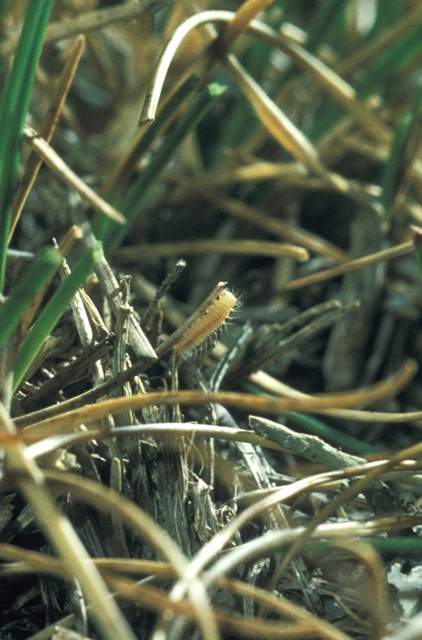 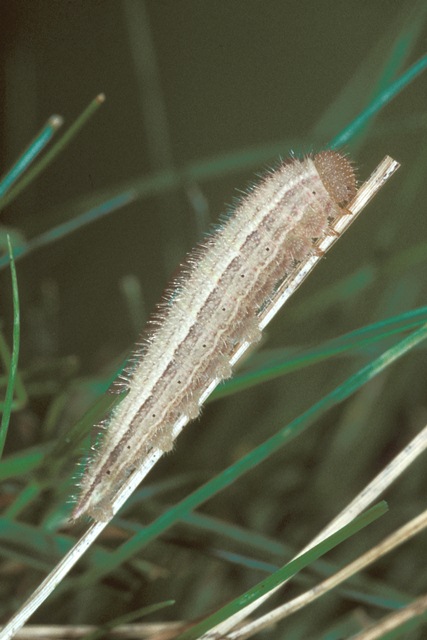 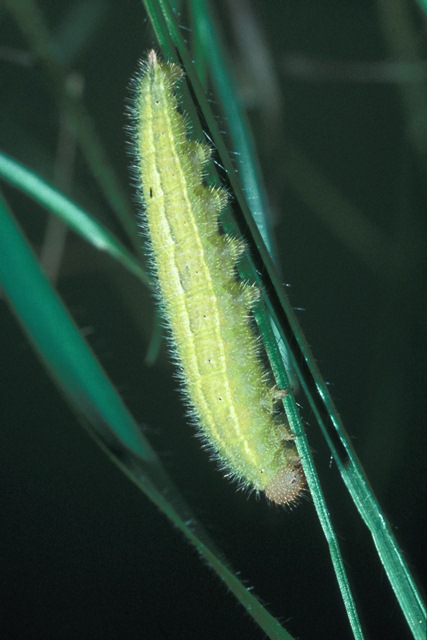
Photographs: Frits Bink ©.
Behaviour in space
From stay-at-home to migrant: stay-at-home, spatial requirement modest.
Finding a mate: male patrols and gathers with females on a flower for nectaring and during the night roosting in tall grass.
Orientation in the landscape: open landscape with a mixture of short and tall grass vegetation.
Oviposition: drops the eggs at random over grasses.
Defence
Threats from other organisms: the remarkable black-white colouration indicates that the butterfly is repellent to avian predators.
Threats from the environment: cold and rainy weather, too luxuriant a growth of the grass.
Feeding habits
Adult: nectar of all kinds of flowers, knapweed often used.
Larva: the newly born aestivates a long time.
Larval foodplants
Plant species: e.g. Brachypodium pinnatum, Bromus erecta, Cynosurus cristatus, Festuca ovina, F. rubra, Phleum pratense.
Journal
Rearing experiment based on specimens from Zinnkoepfle, Vosges, France:
10 & 11 July 1984: females captured.
31 July: eggs hatched.
2 August: all eggs hatched, larvae ate a large part of the eggshell.
5 December: larvae at end first instar and have stopped feeding, no green stuff in the gut, and rest halfway up a grass stem.
Overwintered outdoors.
25 February 1985: pot with tussock taken indoors.
4 March: first larvae in second instar.
22 March: larvae 8-9 mm in length, green and brown coloured morphs seen.
6 April: some larvae in third instar.
15 April: larvae end third instar.
26 April: larvae in moult L4-5.
6 May: biggest larvae mid last instar.
29 May: three pupae, one prepupa, two larvae.
1 June: last prepupa.
6 June: first pupa hatched, male.
8 June: two more hatched, males.
20 June: first female appeared.
26 June: three more females hatched.
27 June: oldest female produced 4 eggs.
30 June: last pupa hatched, female.
Table 84-1. Results of dissections

Table 84-1a. Oviposition sequence

Table 84-2. Collection and observation localities
D, Arnstein 50° 01’ 57”N – 9° 47’ 41”E; 22 July 1984.
D, Lorch, 300m, 50° 02’ 05”N – 7° 47’ 56”E; 14 June 1985, 31 July 1985.
D, Kaiserstuhl, Badberg, 433 m, 48° 05’ 47”N – 7° 40’ 40”E; 9 July 1985.
F, Aurel, 400 m, 44° 43’N – 5° 16’E; 29 August 1984.
F, Lorraine, Dieue-sur Meuse 49° 05’ 11”N – 5° 27’ 25”E; 11 July 1984, 19 August1984, 10 July 85.
F, Lorraine, Lion-devant-Dun, 300 m, 49° 23’ 40”N – 5° 14’ 03”E; 11 July 84.
F, Lorraine, Jaulny, 209 m, 48° 57’ 55”N – 5° 52’ 52”E; 29 June 2002, 8 July 2006.
F, Lorraine, Thillot, 352 m, 49° 01’ 24”N – 5° 39’ 15”E; 25 June 2006.
F, Lorraine, Rupt devant Saint-Mihiel, 280 m, 48° 53’ 01”N – 5° 24’ 10”E; 28 June 2006.
F, Montmédy, 217 m, 49° 31’ 07”N – 5° 21’ 33” E; 18 August 1984.
F, Pagny-la-Blanche-Côte, 308 m, 48° 32’ 37”N – 5° 42’ 58’E; 10 July 1985, 5 July 2006.
F, Velosnes, 179 m, 49° 30’ 09”N 5° 27’ 27”E; 28 June 2002.
F, Vosges, Hohneck, 1283 m, 48° 02’ 03”N – 7° 02’ 27”E; 23 July 1983.
F, Vosges, Tourbière de Machais, 980 m, 48° 00’ 21”N – 6° 57’49”E; 24 July 1983.
F, Vosges, le Zinnkoepfle, 481 m, 47° 57’ 56”N – 7° 15’ 08”E; 10 July 1984.
GB, Dorking 51° 14’ 32”N - 0° 21’ 13”W; 23 July 1981.
GB, Frensham Great Park 51° 09’ 28”N - 0° 47’ 26”W; 21 July 1981.
GB, Oxford, Great Wood 51° 41’N – 0° 55’W; 20 July 1981.
Fig. 84-1. Melanargia galathea, phenogram adapted from Fichefet et al. 2008: 233.
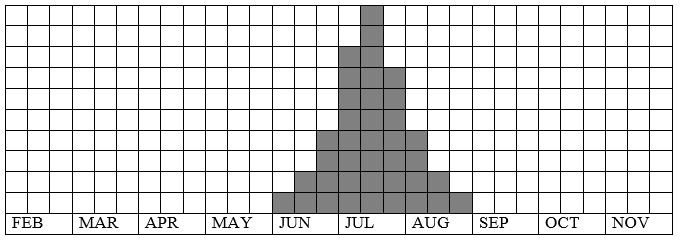
Fig. 84-2. Melanargia galathea, habitat characteristics.
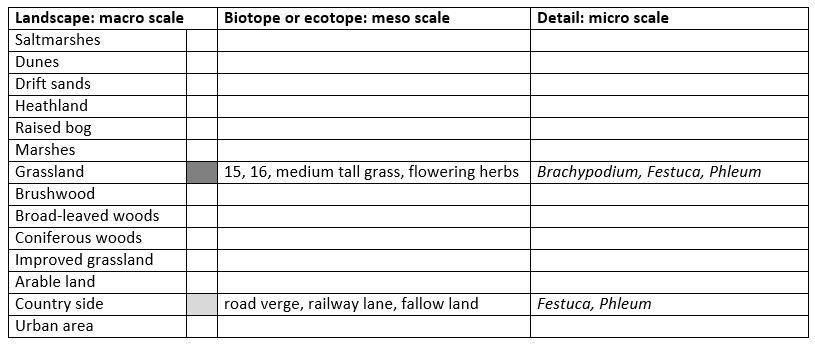
Fig. 84-3. Melanargia galathea, climate matrix, heat-sums 900 - 2200°d.
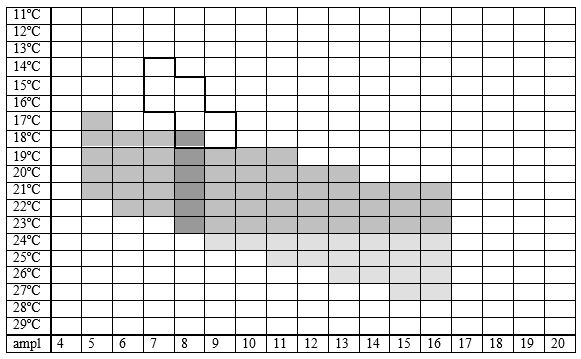
|












